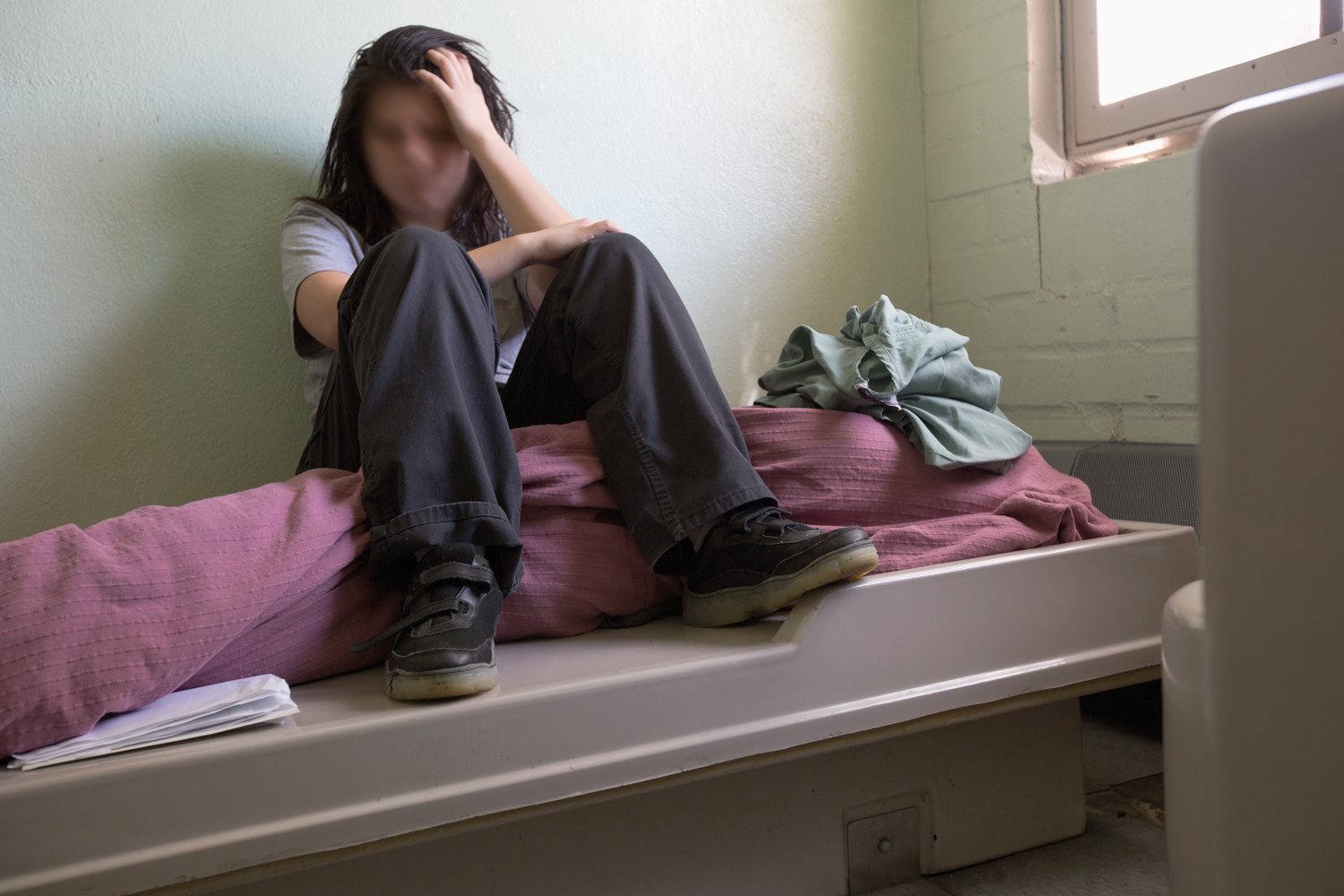
Juvenile (in)justice: girls in the system
Exploring the unique experiences of girls in the juvenile justice system
November 8, 2022
When one envisions the juvenile justice system, images of young delinquents behind bars likely come to mind. Or perhaps a juvenile court is the first image to appear, the judge determining a child’s future with the strike of their gavel. Upon pondering the concept a little deeper, one might even be able to grasp the plight of detained youth. However deep or vivid these perceptions may be, they all likely have one thing in common: the children in the mind’s eye are all boys.
Beneath this veil of assumption lies a population of young women and girls that constitute about 30% of incarcerated youth, according to the U.S. Department of Justice. Despite their proportion in the juvenile justice system, girls’ unique needs are often left unsatisfied and their hardships unrecognized. Such negligence cultivates unparalleled experiences — those of a girl in a system designed for men.
“In all the conversations we have about mass incarceration and criminal justice reform, the focus really tends to be on men and boys,” said Yasmin Vafa, co-founder and Executive Director of Rights4Girls, a human rights organization working to end gender-based violence.
Introducing girls as a point of discussion brings to light the dismal truths about the factors that draw girls into the system, their experiences once “inside,” and the adversity they face upon being released.
The sexual abuse-to-prison pipeline
One of the most significant gender disparities in juvenile justice is the circumstances by which girls are drawn into the system. Girls are most often arrested for nonviolent offenses, including running away from home, skipping school, and prostitution.
“The notion of girls being arrested for prostitution is particularly shocking because, under federal law, any minor under the age of 18 who is engaged in the commercial sex trade is considered a victim of trafficking by definition. And in many states where this is happening, these girls are too young to even be consenting to sex, yet they are being criminalized for prostitution,” Vafa said.
For the vast majority of girls in the juvenile justice system, sexual abuse is not a foreign concept — 80% of girls in some states’ systems have encountered some form of abuse in their lives, according to a report co-authored by Vafa on the sexual abuse-to-prison pipeline. The report also found sexual abuse to be one of the primary predictors of a girl’s entry into the juvenile justice system.
“These girls are essentially being forced to take their safety into their own hands, and so what they end up doing is behaviors to cope with the trauma and abuse. That looks like running away from home if they are being abused at home, running away from foster care if the abuse is happening there, and skipping school if they are either being sex trafficked and their trafficker is forcing them to miss school, or they are experiencing harassment or violence at school,” Vafa said.
The correlation between sexual abuse and interaction with the justice system characterizes the sexual abuse-to-prison pipeline which affects both girls in the juvenile division and women in adult incarceration. However, one of the factors contributing to girls’ arrests is their age.
“So many states will still arrest and detain girls for status offenses, like running away, truancy, and defiant behavior, which are only crimes because of their age,” said Jeannette Pai-Espinosa, president of National Crittenton, a national advocacy organization empowering young women and gender-expansive young people.
While the phenomena surrounding the sexual abuse-to-prison pipeline are not gender-specific, they have a more severe impact on girls who face rates of sexual abuse that are four times higher than boys, according to Rights4Girls.
“It’s important to note that there are boys who have been abused, and they have their own challenges in terms of reporting the abuse and all of the stigma that comes with being a young boy and sexually abused. But from the data that we do have, girls experience abuse at far greater rates than boys,” Vafa said.
In escaping this abuse, girls often become involved in the juvenile justice system, and according to Vafa, it only gets worse from there.
“Instead of really recognizing and responding to this behavior, our system is just basically punishing the girls, and so, as a result, they are becoming involved in the system,” Vafa said. “We discovered that this is really fueling a cycle of victimization and incarceration, including adult incarceration as it becomes an intergenerational cycle.”
A report on the sexual abuse-to-prison pipeline dubbed this violence against girls a “painfully American tale.”
The question of mental health for incarcerated girls
The trauma these detained girls tend to experience leaves them with mental health issues that the system often fails to address. Moreover, there are higher rates of mental illness in girls than boys — 80% of justice-involved girls have mental health diagnoses as opposed to 67% of boys, according to the report on the sexual abuse-to-prison pipeline.
“Mental health is a driver of girls into the system. It is also an outgrowth of this system. And I think neither the juvenile justice system nor the child welfare system has used a mental health lens for the programs and services that they provide,” Pai-Espinosa said.
Mental health is also an important factor to consider when discussing girls in the justice system because these services are often created with adults, particularly male adults, in mind.
“Once girls are involved in the juvenile justice system, they are forced to navigate a system that’s not really designed for them,” Vafa said. “This is a system that is not equipped to respond to the needs of traumatized and abused children.”
Vafa noted that the very conditions that detained youth endure are a source of further trauma.
“Some of the very routine conditions of confinement cause more trauma. Things like strip searches, putting girls in restraints, forcing them to shower and undress in front of guards, and subjecting them to isolation or solitary confinement are obviously harmful and damaging to any child, but particularly traumatic if you consider that so many of the girls coming into the system have been victims of sexual abuse,” Vafa said.
Nadiyah Shereff, a woman from San Francisco who was detained in the juvenile justice system in her youth, described how she felt during her sentence in the report on the sexual abuse-to-prison pipeline.
“I became even more withdrawn and angry. I felt completely disconnected from my family, from friends, and the counselors inside offered no support for the real problems I was facing. I felt like nobody believed that I could actually do something positive with my life — especially the staff inside the facilities, who treated me like a case number, not like a person,” Shereff said.
This dehumanization, as described by Shereff, is the very issue Richard Ross, a photographer known for his documentation of the U.S. juvenile justice system, is trying to address by putting faces to statistics with his nonprofit, Juvenile In Justice. Ross’s project brought him all across the nation, capturing juvenile justice facilities with pictures and quotes obtained through patient conversations with detained youth.
“I would sit on the floor, giving them the authority to be physically and visually above me. They really weren’t used to that. Old white guys are usually towering over them, telling them what to do, instead of sitting on the floor saying: ‘I’m interested in who you are and what’s going on,’” Ross said.
Most detained youth, especially girls, simply want to feel seen.
“At that time, what I needed was to talk to folks about all I had been through, to feel connected to people — to feel useful, so that I could find my own direction in life. I needed to heal from the trauma and to be supported with love and encouragement,” Shereff said.
Improving the system
The flaws in juvenile justice are being addressed by new policy recommendations and revisions to the system, which have become more apparent in recent years. Most of these reforms suggest a more forgiving and supportive environment for detained children and teens.
“I’m working locally with restorative justice as a facilitator so that a person or a kid or whoever, if they do something stupid, like shoplifting, being drunk in public, things like that, they’re not necessarily sent to a lockdown facility, but they have an alternative to make things right,” Ross said.
According to Vafa, this reform will have a particularly positive effect on girls but could improve the system for all justice-involved youth.
“One of the things that we argue for boys and girls is that they are offered services and treatment in the community, instead of being criminalized and detained in a prison-like atmosphere,” Vafa said. “For girls, this almost always makes sense because the vast majority who come into contact with the justice system are nonviolent, and they’re there because of innocuous behaviors like running away and truancy.”
Despite these positive prospects, the plight of girls in the juvenile justice system is still hidden behind cinder block walls, stereotypes, and societal norms.
“I think one of the things that we have to recognize is that the abuse to prison pipeline is still happening, and it’s really important that we continue to collect the data and pay attention to the experiences of girls,” Vafa said. “There’s a lot that we have to do to support not just women and girls, but all those who have suffered violence and exploitation.”



